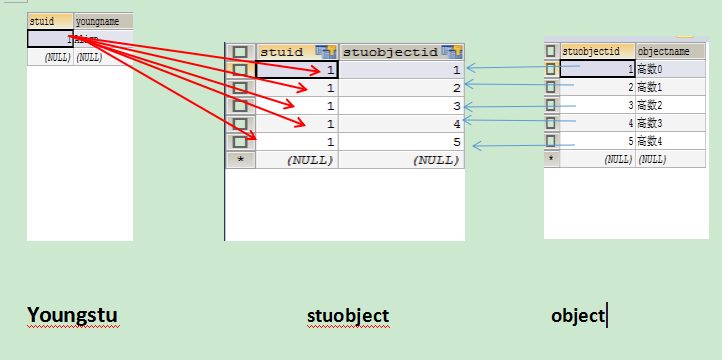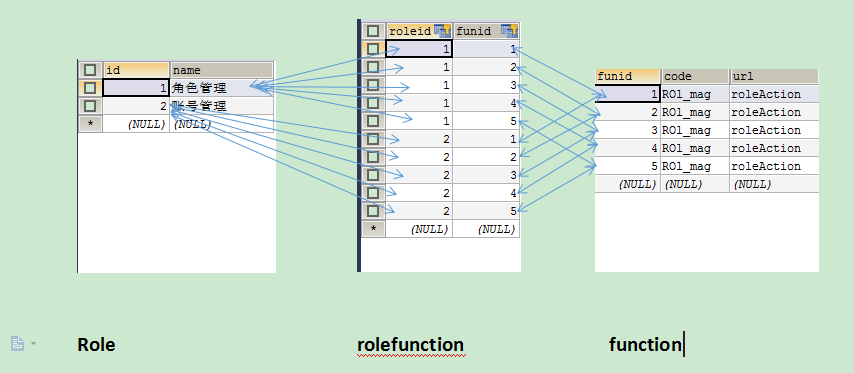Hibernate基於主鍵的單項,雙向多對多對映關係
阿新 • • 發佈:2019-01-11
今天我們來一起談論下hibernate的基於主鍵的單項,雙向多對多對映關係
首先多對多都是基於主鍵的,沒有基於外來鍵的說法
1.基於主鍵的單項多對多

在這裡就是說中間stuobject是一張關係表,將兩張表的主鍵進行關聯,形成了多對多的關係
程式碼如下:
public class StuObject {
private int stuobjectid;
private String objectname;
private StuObject(){}
public StuObject(String objectname){
this.objectname=objectname;
}
public int getStuobjectid() {
return stuobjectid;
}
public void setStuobjectid(int stuobjectid) {
this.stuobjectid = stuobjectid;
}
public String getObjectname() {
return objectname;
}
public void setObjectname(String objectname) {
this.objectname = objectname;
}
}
public class YoungStu {
private int stuid;
private String youngname;
private Set<StuObject 測試程式碼
HibernateUtil.java
public class HibernateUtil {
private static final Configuration cfg;
private static final SessionFactory sessionFactory;
static{
cfg = new Configuration().configure();
ServiceRegistry registry = new StandardServiceRegistryBuilder()
.applySettings(cfg.getProperties()).build();
sessionFactory=cfg.buildSessionFactory(registry);
}
public static Session openSession(){
return sessionFactory.openSession();
}
}
Demo.java
//基於主鍵的單項多對多對映
@Test
public void fkmanytomanyTest(){
Session session=HibernateUtil.openSession();
Transaction tx=session.beginTransaction();
YoungStu youngstu=new YoungStu("Align");
session.saveOrUpdate(youngstu);
youngstu.setStuobject(new HashSet());
for(int i=0;i<5;i++){
StuObject stuobject=new StuObject("高數"+i);
youngstu.getStuobject().add(stuobject);
session.saveOrUpdate(stuobject);
}
tx.commit();
session.close();
}2.雙向多對多對映關係

Role.java
public class Role {
private int id;
private String name;
private Set<Function> function;
public Role(){}
public Role(String name){
this.name=name;
}
public int getId() {
return id;
}
public void setId(int id) {
this.id = id;
}
public String getName() {
return name;
}
public void setName(String name) {
this.name = name;
}
public Set<Function> getFunction() {
return function;
}
public void setFunction(Set<Function> function) {
this.function = function;
}
}
Function.java
public class Function {
private int funid;
private String code;
private String url;
private Set<Role> role;
public Function(){}
public Function(String code,String url){
this.code=code;
this.url=url;
}
public int getFunid() {
return funid;
}
public void setFunid(int funid) {
this.funid = funid;
}
public String getCode() {
return code;
}
public void setCode(String code) {
this.code = code;
}
public String getUrl() {
return url;
}
public void setUrl(String url) {
this.url = url;
}
public Set<Role> getRole() {
return role;
}
public void setRole(Set<Role> role) {
this.role = role;
}
}
role.hbm.xml
<hibernate-mapping>
<class name="hibernatedemo1.pojo.Role" table="role">
<id name="id">
<generator class="increment"></generator>
</id>
<property name="name"/>
<set name="function" table="rolefunction">
<key column="roleid"></key>
<many-to-many class="hibernatedemo1.pojo.Function" column="funid"></many-to-many>
</set>
</class>
</hibernate-mapping>function.hbm.xml
<hibernate-mapping>
<class name="hibernatedemo1.pojo.Function" table="function">
<id name="funid">
<generator class="increment"></generator>
</id>
<property name="code"/>
<property name="url"></property>
<set name="role" table="rolefunction">
<key column="funid"></key>
<many-to-many class="hibernatedemo1.pojo.Role" column="roleid"></many-to-many>
</set>
</class>
</hibernate-mapping>這兩個hbm.xml裡面要注意
<set name="function" table="rolefunction">
<key column="roleid"></key>
<many-to-many class="hibernatedemo1.pojo.Function" column="funid"></many-to-many>
</set>
<!--這兩個裡面的column一定要一一對應,不能隨便-->
<set name="role" table="rolefunction">
<key column="funid"></key>
<many-to-many class="hibernatedemo1.pojo.Role" column="roleid"></many-to-many>
</set>